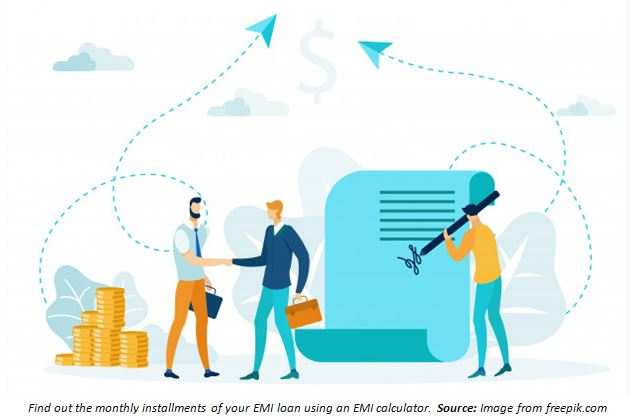A definitive guide to loan EMI in India in 2020
There comes a time when you desire to take the leap of faith for the betterment of yourself, your family, and your personal goals. For this you need a booster that can provide you guaranteed assistance, like studying abroad, owning your own business, buying your dream property, and many more. This assistance is provided by the banks in the form of loans which is a kind of credit vehicle in which a sum of money is loaned to another party in exchange for future repayment of the value or principal amount. In addition to the principal balance, the lender also adds interest and/or financing charges to the principal value that the borrower must repay. Loans may be for a particular, one-time amount or may be available as an open-ended credit line up to a specified limit. Loans come in a variety of ways including secured, unsecured, commercial, and personal lending.
What is EMI Loan?
The full form of EMI is Equated Monthly Installment. EMI consists of two fundamental amounts: repayment of the amount associated with the principal on the outstanding of your loan and payment of the interest. A longer holding of loans (for a maximum period of 30 years) helps to reduce the EMI.
What's an EMI Calculator for Loan?
Loan EMI Calculator assists in credit installment calculation i.e. EMI to your credit. It's an easy-to-use calculator and acts as a tool for a buyer to plan financially. It is essential that you are aware of the monetary obligations towards the bank or financial institution financing your purchase in order to avoid a future showdown. With an EMI calculator, you can conveniently plan ahead your finances.
EMI Components
There are two major components of EMI - Principal and Interest
Factors Impacting EMI
- Amount of loan: The loan amount is the primary factor that determines the EMIs. The loan amount and EMI follow a direct relationship, the increase in the loan amount, increases the EMIs
- Rate of Interest: This is another factor affecting the EMIs, EMIs are directly proportional to the rate of interest. The parameters which are used for calculating the interest rate are your income, credit history, prevailing market situation, repayment capacity, etc
- Tenor: Tenor has an inverse relationship with EMIs longer the tenor generally means lower EMIs and vice versa. Longer tenors however also mean a higher outgoing interest
EMI may change due to certain factors:
- Floating rate of interest: The floating rate of interest means the interest rate will be dynamic according to the market conditions. The rates are directly proportional which suggest when the interest rate falls, the EMI will fall as well
- Loan payment: If there is a prepayment of a certain amount of the credit, your EMI will change. The primary amount goes down subsequently which affects the EMI
Progressive EMI: Certain moneylenders let you pay your EMIs progressively as your source of income keeps on increasing with time, this kind of method is generally used for a longer loan period.

Step 1: Application for your Loan
The procedure for a loan starts with the bank making a formal request. To assess and scrutinize the eligibility for the loan you are also required to provide the bank with your personal details. The following documents are required by banks in general:
- Address proof
- Age proof
- Income proof
- Pan card
- Aadhaar card
- Employment details
- Professional qualifications
- Proof of identity
- Property proof
Step 2: Payment of fees to process loans
There is a non-refundable fee charged by the bank for loan-processing fees. Generally, the fees vary from 0.5 to 1 percent of the loan amount. This amount taken by the bank is for commencing and maintaining the loan process. During this situation of the pandemic, the banks have started waiving off the loan processing fees to attract borrowers. You can negotiate for the fees and avail of the benefits of this.
Step 3: Verification of applicant
The bank evaluates your case and decides the amount which they can loan you after the submission of your application and documents. The bank authorities will have a meeting with you, where they will discuss the repayment capacity. Post the meeting, the bank will verify all the facts and credentials you had provided with the application. The bank representative will verify your workplace and the residential property to validate the information provided in the application.
Step 4: Repayment capacity evaluation
The repayment capacity evaluation is the most important step of the process that will determine if you can pay the principal amount with interest on time, which will define the bank sanctioning or denying the loan.
Step 5: Offer Letter for loan
The bank drafts an offer letter with the following information:
- Amount sanctioned
- Applicable Rate of interest
- Fixed or floating rate of interest
- Tenure of loan
- Repayment method
- Loan’s terms and conditions
If the terms and conditions of the letter of offer are acceptable to you, you must submit a signed acceptance copy to the bank. This is essentially a duplicate of the offer letter which the bank keeps for the record.
Step 6: Disbursal of loan
Once all the formalities mentioned above are completed, the process of registration for loan commences. Legal documents must be prepared in a format approved by the bank 's lawyer on stamp papers of the denominations required. Post this, for the agreed term, you will be required to submit post-dated checks and sign the loan agreement. After you sign the loan agreement, the loan disbursement process will commence. Your bank will dispense with the amount of the loan, depending on the type of disbursement agreed upon (whether lump-sum or in stages).
The comparative analysis of the best option from various lenders should be done to know which one suits your needs the best way possible. This can be easily done using an EMI calculator- a free tool available online which can be used as many times as you want. A loan is a liability for you, which should be planned carefully by analyzing your income, cash flows, etc.
To join us on Facebook Click Here and Subscribe to UdaipurTimes Broadcast channels on GoogleNews | Telegram | Signal



